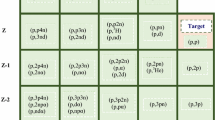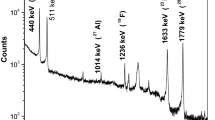Abstract
In an effort to develop DS02, a new radiation dosimetry system for the atomic bomb survivors of Hiroshima and Nagasaki, measurements of neutron-induced activities have provided valuable information to reconstruct the radiation situation at the time of the bombings. In Hiroshima, the depth profile of 152Eu activity measured in a granite pillar of the Motoyasu Bridge (128 m from the hypocenter) was compared with that calculated using the DS02 methodology. For calculation of the 152Eu production due to the thermal-neutron activation reaction, 151Eu(n,γ)152Eu, information on the hydrogen content in granite is important because the transport and slowing-down process of neutrons penetrating into the pillar is strongly affected by collisions with the protons of hydrogen. In this study, proton–proton elastic recoil coincidence spectrometry has been used to deduce the proton density in the Motoyasu pillar granite. Slices of granite samples were irradiated by a 20 MeV proton beam, and the energies of scattered and recoil protons were measured with a coincidence method. The water concentration in the pillar granite was evaluated to be 0.30 ± 0.07%wt. This result is consistent with earlier data on adsorptive water (II) and bound water obtained by the Karl Fisher method.






Similar content being viewed by others
References
Young RW, Kerr GD (eds) (2005) Reassessment of the atomic bomb radiation dosimetry for Hiroshima and Nagasaki. Dosimetry System 2002 (DS02 Report). Radiation Effects Research Foundation, Hiroshima
Hasai H, Iwatani K, Shizuma K, Hoshi M, Yokoro K, Sawada S, Kosako T, Morishima H (1987) Europium-152 depth profile of a stone bridge pillar exposed to the Hiroshima atomic bomb: 152Eu activities for analysis of the neutron spectrum. Health Phys 53:227–239
Shizuma K, Iwatani K, Hasai H, Hoshi M, Oka T (1997) 152Eu depth profiles in granite and concrete cores exposed to the Hiroshima atomic bomb. Health Phys 72:848–855
Endo S, Iwatani K, Oka T, Hoshi M, Shizuma K, Imanaka T, Takada J, Fujita S, Hasai H (1999) DS86 neutron dose: Monte Carlo analysis for depth profile of 152Eu activity in a large stone sample. J Radiat Res 40:169–181
Cohen BL, Fink CL, Degnan JH (1972) Nondestructive analysis for trace amount of hydrogen. J Appl Phys 43:19–25
Jarvis ON, Sherwood AC (1974) Non-destructive measurement of hydrogen in thin sheet materials. Nucl Instr Meth 115:271–275
Chu WK, Wu DT (1988) Scattering recoil coincidence spectrometry. Nucl Instrum Methods B 35:518–521
Hofsäss HC, Parikh NR, Swanson ML, Chu WK (1990) Depth profile of light elements using elastic recoil coincidence spectrometry (ERCS). Nucl Instrum Methods B 45:151–156
Reichart P, Dollinger G, Bergmaier A, Datzmann G, Hauptner A, Körner HJ (2002) Sensitive 3D hydrogen microscopy by proton proton scattering. Nucl Instrum Methods B 197:134–149
Berger P, Gallien JP, Khodja H, Daudin L, Berger MH, Sayir A (2006) Hydrogen incorporation into high temperature protonic conductors: Nuclear microprobe microanalysis by means of 1H(p, p) 1H scattering. Nucl Instrum Methods B 249:527–531
Furuno K, Komatsubara T, Sasa K, Oshima H, Yamato Y, Ishii S, Kimura H, Kurosawa M (2003) Measurement of hydrogen concentration in thick mineral or rock samples. Nucl Instrum Methods B 210:459–463
Komatsubara T, Sasa K, Okumoto K, Ishii S, Yamato Y, Satou K, Furuno K, Kurosawa M (2006) Development of ERCS hydrogen analysis for melt inclusions in erupted magmatic samples. Nucl Instrum Methods B 251:237–245
Czamanske GK, Ishihara S, Atkin SA (1981) Chemistry of rock-forming minerals of the Cretaceous-Paleocene Batholith in southwestern Japan and implications for magma genesis. J Geophy Res 86:10431–10469
Yurimoto H, Kurosawa M, Sueno S (1989) Hydrogen analysis in quartz crystals and quartz glasses by secondary ion mass spectrometry. Geochim Cosmochim Acta 53:751–755
Author information
Authors and Affiliations
Corresponding author
Rights and permissions
About this article
Cite this article
Komatsubara, T., Sasa, K., Ohshima, H. et al. Hydrogen analysis for granite using proton–proton elastic recoil coincidence spectrometry. Radiat Environ Biophys 47, 337–342 (2008). https://doi.org/10.1007/s00411-008-0175-y
Received:
Accepted:
Published:
Issue Date:
DOI: https://doi.org/10.1007/s00411-008-0175-y




